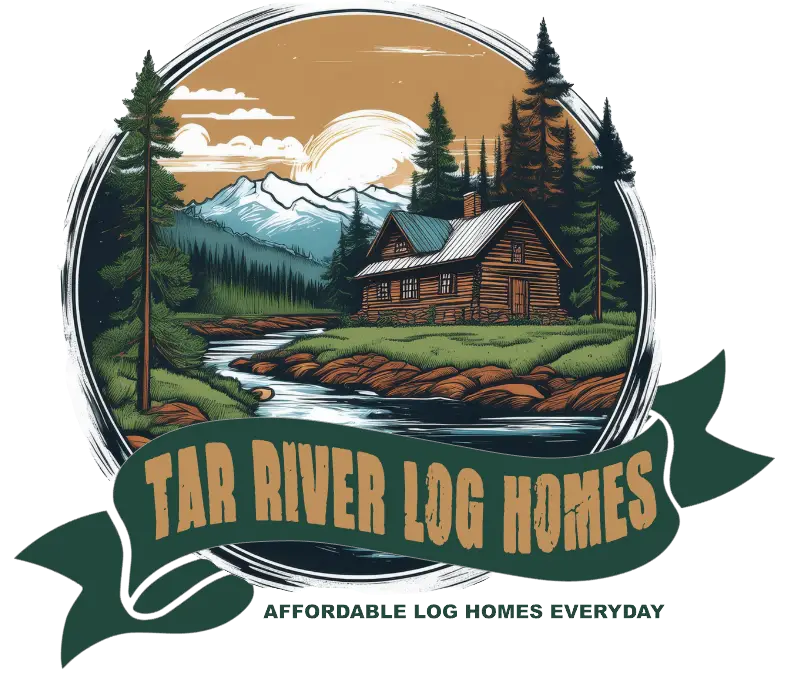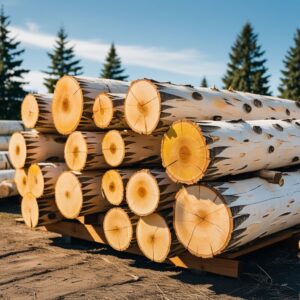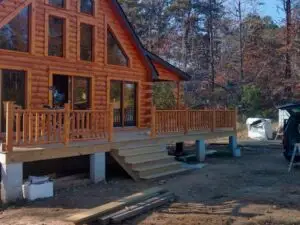Building a log home is a big dream for many families. But it doesn’t have to come with a big price tag.
Eastern white pine logs make that dream possible. They’re strong, easy to work with, and kinder on your budget than many other woods.
At Tar River Log Homes, we believe in keeping things simple and honest. That means wholesale pricing, quality materials, and no hidden extras.
Eastern white pine has been trusted for generations. Its natural insulation, clean look, and lightweight design make it a smart choice for anyone who wants a home that’s both cozy and practical.
In this guide, we’ll cover the key benefits of eastern white pine logs—and why they’ve remained a favorite for building homes that last.
Understanding Eastern White Pine Logs
Eastern white pine logs are well-loved for their pale color, straight grain, and how simple they are to use. Builders have relied on them for ages, and careful harvesting keeps the wood both strong and sustainable. Knowing a bit about the wood helps you make a smarter choice for your project.
What Is Eastern White Pine?
Eastern white pine is a softwood native to the northeastern U.S. and parts of Canada. These trees shoot up tall—sometimes 80 to 150 feet—so you get long, solid logs.
The wood itself is lightweight, pale, and smooth. It’s a breeze to cut and shape, which is a relief if you want to customize your log home. Insulation’s good too, so winters feel warmer and summers stay cooler.
These logs don’t crack as much as other pines, so your house holds together longer. You get a nice balance of strength and a bit of give—perfect for log cabins.
Historical Use of Eastern White Pine Logs
People have been using eastern white pine for centuries—homes, ships, furniture, you name it. Early American settlers loved it because it grew big and straight.
Back in colonial days, it showed up everywhere, from barns to houses. The wood’s lightness made it easier to move, even on rough roads or rivers. Communities could build fast using what was nearby.
A lot of the old log homes are still standing today? Eastern white pine. Folks valued it for lasting power and the way it aged without twisting out of shape.
Sourcing and Harvesting Practices
If you want top-notch eastern white pine, go with suppliers who actually care about sustainability. They harvest carefully and replant, keeping forests going strong.
Younger trees usually give you straight, smooth logs. Kiln drying pulls out moisture, so you don’t have to worry about warping or rot before your home’s even up.
Find a contractor who kiln-dries and custom-cuts the lumber to fit your design. Less waste, fewer headaches, and better prices. Getting logs straight from a trusted source means you save cash and get wood that’s already been checked for quality. Your build stays sturdy, and you’re doing right by the environment.
Unique Benefits of Eastern White Pine Logs
Eastern white pine logs really shine for their insulation, strength, and how easy they make the building process. If you’re thinking about a log home, these are hard to beat. You get natural warmth, solid structure, and lighter logs that make everything go smoother.
Natural Insulation Qualities
Eastern white pine is a surprisingly good insulator. Its structure traps air, so your house stays warmer in winter, cooler in summer. You’ll probably notice the difference in your energy bills and comfort.
Unlike some hardwoods, white pine’s natural oils help it shrug off moisture, lowering the risk of mold or rot. That means less hassle and fewer repairs. If holding a steady temperature matters to you, these logs are a solid, natural pick.
Energy Efficiency and Thermal Mass Benefits
Log walls act like “thermal batteries.” A NAHB study shows a 6″ solid log wall can be 7% more energy efficient than a standard 2×6 framed wall with R‑19 insulation. This is thanks to the log’s thermal mass. It’s the ability to absorb heat during the day and release it gradually at night, reducing heating and cooling needs.
Strength and Durability Features
Eastern white pine logs might be softwood, but they’ve got plenty of backbone. They handle wind and snow loads well, which is a relief for safety.
Sure, they aren’t as tough as oak, but they’re dense enough to resist those annoying daily dents and scratches. Treated right, they’ll fight off decay for decades.
Lightweight Construction Advantages
One thing you’ll love: these logs are light. That makes them easier to move and put in place, whether you’re doing it yourself or hiring a crew.
You save time and money on labor. Lighter logs also mean less stress on your foundation, so settling problems are less likely.
Visual and Design Appeal
Eastern white pine logs have a natural look that fits just about any home style. The grain is distinct but not wild, the color is soft, and finishing options are wide open.
Aesthetic Grain Patterns
You’ll notice the clear, straight grain—clean and classic. Occasional knots give the logs some personality but don’t overwhelm the look. This makes it easy to blend with rustic or modern decor, whichever way you lean.
The texture is smooth once sanded, so paint or stain goes on easily. Over time, the grain deepens a bit, adding quiet character. For a timeless vibe, these patterns really fit log walls well.
Color Variations
White pine logs run from creamy white to pale yellow, with light brown touches near knots. The palette is soft and inviting—never harsh.
You get enough consistency for a unified look, but the natural variation keeps things interesting. Lighter colors help open up rooms and make spaces feel bigger, which is a bonus if you like that airy feel.
Finishing and Customization
Finishing options are simple and flexible. Want to keep the natural look? Use a clear sealer. Prefer a little more color? Stains work great.
Since the wood is soft, you can sand or carve it for custom details. Kiln-dried logs hold finishes longer, so you won’t have to redo them constantly. A good finish protects against weather and wear, giving you a polished look that lasts.
Sustainability and Environmental Impact
Choosing eastern white pine logs is a win for the environment. The wood comes from renewable forests, has a low carbon footprint, and fits right into eco-friendly building practices.
Indoor Air Quality and Health Benefits
Eastern white pine, being natural and untreated, typically emits fewer volatile organic compounds (VOCs) than many chemically treated building materials.
This supports healthier indoor air, especially important for families or allergy‑sensitive individuals. Learn more about indoor air quality basics and how materials impact health from the EPA:
“Indoor Air Quality (IAQ) refers to the air quality within… as it relates to the health and comfort of building occupants.”
Eco-Friendliness of Eastern White Pine
Eastern white pine grows fast, so forests bounce back quickly after harvesting. Responsible management means new trees are planted and forests stay healthy.
This wood needs less chemical treatment than some others. It naturally resists decay and pests, so you’re not adding a bunch of harsh stuff to your build. That’s a plus for anyone who cares about cleaner living.
Renewable Resource Advantages
Eastern white pine is a renewable resource. Forests are managed for a steady supply, so there’s no risk of running out. Sustainable forestry keeps the land productive year after year.
By building with this wood, you’re part of a cycle that keeps forests alive and thriving. That’s a big deal for anyone who wants a home that’s good for both people and the planet.
Low Carbon Footprint
Eastern white pine logs help lower carbon emissions compared to concrete or steel. Trees soak up carbon dioxide as they grow, and the logs keep that carbon locked in.
When you get quality logs, you’re using materials that don’t take much energy to process. That keeps your home’s carbon footprint down and makes a difference for the climate.
Performance in Construction Projects
Eastern white pine logs bring solid strength and flexibility to all sorts of builds. They work for different styles and hold up outdoors, so you can count on them.
Ease of Workability
Eastern white pine is soft, which makes it a lot easier to cut, shape, or drill. That saves you time and hassle.
The wood takes nails, screws, and glue well, so putting things together is straightforward. No need for fancy tools or special hardware.
It sands and stains evenly, so you have real control over the finished look. Whether you’re building solo or with help, the process just goes smoother.
Versatility in Building Styles
This pine works with all kinds of log home designs, from old-school cabins to sleek modern builds. The grain and color are easy to pair with beams or other materials. You can use it for walls, roofs, or framing. It’s flexible, so custom shapes or creative touches are no big deal.
Longevity in Outdoor Applications
Eastern white pine stands up to weather when you treat it right. It resists warping and cracking, so your logs stay solid through rain, sun, and cold.
Regular sealing or staining keeps moisture and pests out, adding years to your home’s life and saving you money.
A lot of folks trust eastern white pine for porches, decks, and exterior walls. It’s strong, easy to maintain, and just works.
Eastern White Pine vs. Other Log Species
Eastern white pine stands out for its balance of strength, affordability, and user-friendliness compared to other popular log species. It offers unique benefits depending on what you want for your home.
Comparison to Western Red Cedar
Western red cedar is famous for resisting rot and bugs. But eastern white pine is lighter and easier to work with, which is a real plus if you’re thinking of doing some of the building yourself.
Cedar’s got a deeper color and that classic scent, but pine brings a softer, warmer vibe that fits inside most homes. It’s usually more affordable, too. If you’re watching costs, eastern white pine gives you good value without cutting corners.
Differences from Douglas-Fir
Douglas-fir is tougher and heavier, which is great for major structural needs. But it’s harder to cut and shape, especially if you’re going the DIY route.
Eastern white pine’s lighter weight means less heavy lifting. It also insulates better thanks to its lower density. That can help with heating and cooling bills. If you want logs that are easy to handle and still last, pine is a practical pick.
Benefits Over Spruce and Fir
Spruce and fir are common, but they can crack and shrink more as they dry. Eastern white pine doesn’t shrink as much, so you get fewer gaps and less maintenance. It’s got a smoother grain, making it easier to seal and stain. Paint and finish stick around longer, too. If you want logs that keep their shape and look, pine is a smart bet.
Care and Maintenance of Eastern White Pine Logs
Looking after your eastern white pine logs means keeping them safe from weather, bugs, and wear. A bit of regular care helps your home stay strong and comfortable. Paying attention to treatments and seasonal upkeep will keep your logs in shape for years.
Preserving Log Integrity
Keep your logs dry and sealed to fight off rot and insects. Check for cracks or gaps now and then, and fill them with a good caulk meant for log homes. That keeps moisture out.
Make sure air can move around your home. Trim back bushes and plants so things dry faster after rain. Gutters and roofs should push water away from the logs—water pooling is bad news.
Recommended Treatments
Treat your logs with a stain or sealer that protects but lets the wood breathe. Go for products made for eastern white pine or softwoods. These block UV rays and keep moisture out.
A penetrating oil stain every 3-5 years is a good rule of thumb. Before treating, wash your logs with mild soap and water—skip harsh chemicals that could hurt the wood. With a little effort, your logs will stay weather-resistant and keep their natural beauty a lot longer.
Seasonal Maintenance Tips
Spring and fall—those in-between months—are the perfect times to give your logs a once-over. After winter, check for water damage or signs of bugs. Grab a soft brush and some mild soap to clean off dirt and mildew; nothing fancy is needed.
When it’s warm, peek at those sealed joints and slap on some new caulk if you spot gaps. If the weather’s dry, look for cracks from wood shrinkage and fill them before they get worse. Honestly, just sticking to a maintenance schedule makes life easier and can save you a lot of money and headaches down the road.
Why Eastern White Pine is a Smart Choice for Your Home
Eastern white pine logs offer a balance of strength, warmth, and affordability that’s hard to beat. They’ve been trusted for centuries and remain a top choice for building homes that last.
With the right care, your log home can stay sturdy and beautiful for generations. The wood’s natural insulation, easy workability, and timeless look make it a smart choice for families who want comfort without overspending.
At Tar River Log Homes, we’re here to supply quality eastern white pine logs at wholesale prices.
When you’re ready to start your project, we’ll make sure you get the right materials at the right value.
Frequently Asked Questions
Eastern White Pine logs really bring a nice mix of strength, workability, and looks. People use these logs for all sorts of home projects since they’re versatile and have some great natural qualities.
Why is Eastern White Pine popular in construction?
Eastern White Pine is light, so you don’t break your back hauling it around. It’s easy to cut, nails stay put, and it’s just as good for framing as it is for finishing.
What unique characteristics do Eastern White Pine logs have?
The grain runs straight and feels pretty smooth. The pale color takes stain or paint well, and, honestly, it just looks good. Compared to other softwoods, it shrinks and warps less, which is always a plus.
How does the durability of Eastern White Pine compare to other woods?
It’s moderately tough—definitely not as rot-resistant as something like oak. But if you treat and care for it, it’ll last indoors or in covered spots outside.
Can Eastern White Pine logs be used for outdoor projects?
You can use them outdoors, sure, but you’ve got to keep them sealed and watch for pests. Preservatives and finishes are your friends if you want them to last out there.
What maintenance is required for Eastern White Pine structures?
Take a look at the logs once a year for cracks or any damage. Every few years, throw on a new coat of stain or sealant to keep the weather and bugs away. Keeping up with this stuff saves you from bigger repairs later.
Are there any sustainability advantages to using Eastern White Pine?
Eastern White Pine grows pretty quickly, and you can find it in a lot of places. If you pick this wood, you’re supporting responsible forestry—plus, it just feels better knowing your log home’s a bit more eco-friendly.
At Tar River Log Homes, we’ll cut Eastern White Pine logs to your specs, no nonsense or weird markups. You get solid materials without paying extra for stuff you don’t need.




